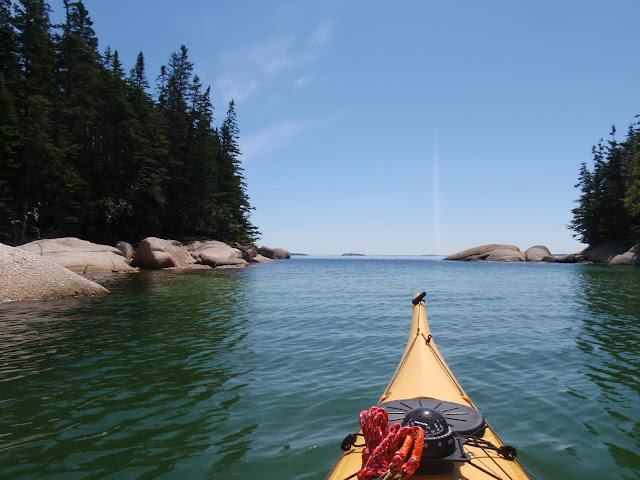OK, BaffinPaddler has posted her Stonington photos, Each and Everyone has posted his photos. I think it’s pretty clear who is keeping their blogs current and who is concentrating on finishing the frozen tiramisu before a hurricane-induced power outage ruins it.
 |
| Two bloggers head out |
Anyway, what can we say, Stonington, is an amazing place, BaffinPaddler is an amazing Greenland style paddler. It was just so much fun to be entertained by her and her companion on Tuesday, that we asked if we could come back and do it all again on Friday.
Our Tuesday outing was a remarkably clear day, and we ventured out through the maze of islands to Gooseberry. This was similar to a trip we'd done last year. But this year we had an unscheduled convergence with the Each and Everyone blogger and his sparkling blue Capella.
 |
| Each and Everyone Blogger arrives at Gooseberry |
Friday was unfortunately shorter, but no less enjoyable. We visited the harbor, and inner islands, discovering a perfect little beach we'd never noticed before.
A few stories; BaffinPaddler asked me for suggestions of where to paddle in Maine. I suggested Stonington, specifically Old Quarry Ocean Adventures. Old Quarry has a beautiful location on Webb Cove.
 |
| A view from Old Quarry |
Also on Webb Cove is an active lobster facility, which sent over a dozen boats by her tent early in the morning. To be fair, almost all of coastal Maine has that same issue. But never-the-less she was always in a good mood, energetic, ready to head out to paddle and do yoga.
Baffinpaddler was just back from a Paddle to Yoga tour she’d led in the Thousand Islands, and eager for similar adventures on the ocean. She’d also spent a lot of time paddling in the Georgian Bay, off Lake Huron, which in her understated way she mentioned was the “size of a lake.” The size of a great lake, about as big as Massachusetts. She had a healthy respect for the cold Atlantic waters and their mercurial nature.
She made the Georgian Bay area sound very appealing, with its deep clear waters. However as we approached an island, she asked if there were bears there, because on the Georgian Bay apparently bears thrive on the islands. Believe me, I would not be nearly as enthusiastic about Stonington if the islands had bears. And I noted the importance of her recommendation about using a good outfitter with local knowledge on the Georgian Bay waters.
 |
Maelstroms react to the notion of bears on islands |
Paddling with two bloggers and four photographers meant a lot of breaks, and some great entertainment while on land as we checked out each other’s artistic visions. We all took photos of a toadstool and a skull. Hopefully Baffinpaddler was happy with her shots, in ours the focus was never right, instead we’ll substitute this picture of the same skull (a groundhog??) on a rock.
We saw many lobster boats and were often surprised at how close to shore they went. As Baffinpaddler noted, "There is no place where they do not go." Lobster boats are cautious in the Stonington area, but kayaks are low and not always visible to them.
 |
| Baffinpaddler prepares herself for yoga on a perch |
The picture above was taken on Russ Island. Back when Mark and I made regular runs to clean the island, we always landed on a broad shell beach there. Here we are on a run in 2007.
At first I thought it washed away over the years, but now as I check the rocks and angles, I suspect it is just a tide issue. We generally would have aimed for a low tide cleaning, that's probably why I think of Russ as having an expansive beach there.
Fortunately one my favorite sights, the round rock boulder field of Gooseberry, is there at all tides.
 |
| The boulder field of Gooseberry |
Stonington carries many scars from granite quarrying, where island shores are replaced with granite tailings. Being there always makes me a bit negative toward using granite in kitchens. It's one thing to scar the land for timeless memorials, another for a room which will be redecorated in a few years.
 |
| This boulder on Green Island shows how slabs are cut |
We’d managed to encourage Baffinpaddler to visit on a week with two high wind days and an impending hurricane! Pretty impressive timing. I hope they can forgive us and come back some day to do other great areas, like Castine and Camden.
A few more photos from our adventures:
 |
| A schooner near Wreck |
 |
| Looking from Gooseberry out to Isle au Haut |
 |
| An inuksuk |
 |
| Just a pretty plant |
 |
| Waiting for a schooner to clear the thorofare |
And now, the server battery has only a few minutes left, so I guess I'll post this and make corrections later.
















































